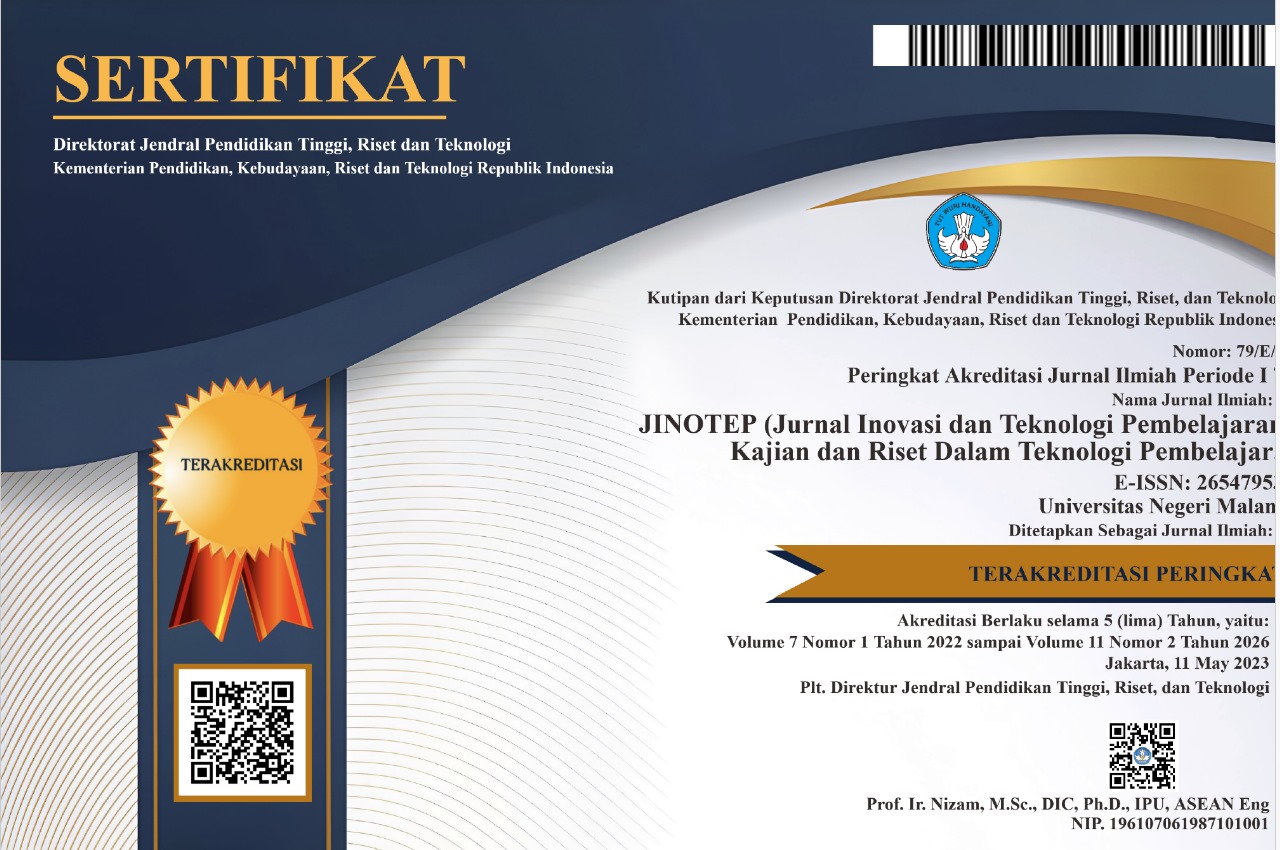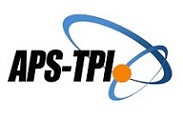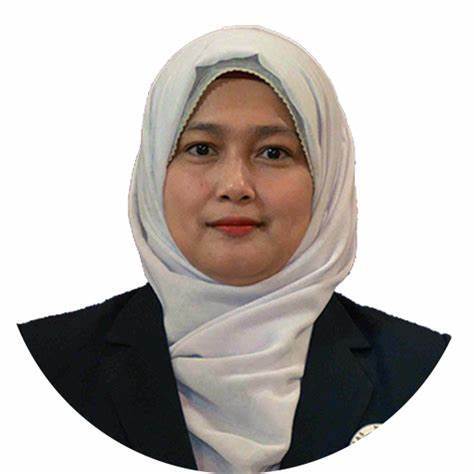Pengaruh Universal Design For Learning (UDL) Berbasis Social Learning Networks (SLN) Terhadap Hasil Belajar Mahasiswa STKIP PGRI Situbondo
Abstract
Abstrak: Penelitian ini merupakan penelitian eksperimen dengan menggunakan rancangan eksperimental, pretest & posttest control group design. Terdapat dua kelompok dalam penelitian ini, yaitu kelompok eksperimen yang menerapkan perlakuan pembelajaran UDL berbasis SLN dan kelompok kontrol yang tidak menerapkan perlakuan. Subjek penelitian ini melibatkan mahasiswa sebanyak 45 orang di STKIP PGRI Situbondo yang mengambil mata kuliah Telaah Kurikulum. Data yang dikumpulkan dalam penelitian ini diolah dengan bantuan program SPSS for windows versi 22.0 dengan teknik analisis data paired sample t test untuk menguji hipotesis penelitian. Hasil penelitian menunjukkan bahwa terdapat perbedaan hasil belajar antara kelompok eksperimen (78,00) yang diberi perlakuan pembelajaran UDL berbasis SLN dengan kelompok kontrol (71,50) yang tidak diberi perlakuan. Hal ini juga dibuktikan dari hasil perhitungan menggunakan normalized gain diperoleh gain untuk kelompok eksperimen (0,38) sedangkan kelompok kontrol (0,12). Selisih rata-rata gain kelompok eksperimen dan kelompok kontrol adalah 0,38 – 0,12 = 0,26, dengan demikian dapat dikatakan bahwa pembelajaran UDL berbasis SLN efektif untuk meningkatkan hasil belajar mahasiswa. Dalam pengujian hipotesis menggunakan t test didapatkan hasil thitung sebesar 3,630 apabila dibandingkan dengan ttabel sebesar 1,729 yang berarti thitung > ttabel (3,630 > 1,729), artinya dengan demikian H1 diterima. Jadi kesimpulannya pembelajaran Universal Design for Learning berbasis Social Learning Networks berpengaruh terhadap hasil belajar secara signifikan.
Abstract. This research is an experimental research using experimental design, pretest & posttest control group design. There were two groups in this study, namely the experimental group that applied the SLL-based UDL learning treatment and the control group that did not apply the treatment. The subject of this study involved 45 students at STKIP PGRI Situbondo who took the Curriculum Study course. The data collected in this study were processed with the help of the SPSS for Windows version 22.0 program with paired sample t-test data analysis techniques to test the research hypothesis. The results showed that there were differences in learning outcomes between the experimental group (78.00) who were treated with SLL-based UDL learning and the untreated control group (71.50). This is also proven from the results of calculations using gain normalized obtained gain for the experimental group (0.38) while the control group (0.12). The difference in gain of the experimental group and the control group is 0.38 - 0.12 = 0.26, thus it can be said that the SLL-based UDL learning is effective for improving student learning outcomes. In testing the hypothesis using t-test the results of t-count are 3,630 when compared with t-table of 1,729 which means tcount> t table (3,630> 1,729), meaning that H1 is accepted. So the conclusion is the learning of Universal Design for Learning based on Social Learning Networks has an effect on learning outcomes significantly.
Keywords
Full Text:
PDFReferences
Abdell, M., & Lewis, P. (2005). Universal Design for Learning: A Statewide Improvement Model for Academic Success. Information Technology and Disabilities, XI.
Abdurrahman, M. (2003). Pendidikan Bagi Anak Berkesulitan Belajar. Jakarta: Rineka Cipta.
Borg & Gall. (2003). Education Research. New York: Allyn and Bacon. Creswell, J.W. (2012). Education Research: Planning, Conducting, and Evaluating Quantitative and Qualitative Research. Boston: Person.
Firmansyah, Beny H. (2015). Pengembangan Blended Learning Berbasis Schoology. Prosiding Seminar Nasional Teknologi Pendidikan. 86-102. Malang: Prodi TEP UM.
Firmansyah, B.H., Toenlioe, A.J.E., & Ulfa, S. (2016). Universal Design for Learning Sebagai Sarana Untuk Memfasilitasi Perbedaan Gaya Belajar Peserta Didik Dalam Belajar. Prosiding Seminar Nasional Teknologi Pembelajaran dan Psikologi Pendidikan. Malang: PPs UM.
Halimi, K., Seridi, H., & Zucker, C.F. (2011). Solearn: Social Learning Network. International Conference and Computational Aspects of Social Network (CASoN). 130-135.
Hitchcock, C., Meyer, A., Rose, D., & Jackson, R. (2002). Providing New Access to the General Curriculum: Universal Design for Learning. TEACHING Exceptional Children, 35, 8-17.
Kementerian Pendidikan dan Kebudayaan Universitas Negeri Malang. (2012). Pedoman Penulisan Karya Ilmiah: Skripsi, Tesis, Disertasi, Artikel, Makalah, Tugas Akhir, Laporan Penelitian. Edisi Kelima. Malang: UM.
Meyer & Rose. (2000). Universal Design for Individual Differences. Educational Leadership.
Nielsen. (2011). Pertumbuhan Pengguna Ponsel di Indonesia Paling Tinggi. retrieved 23 Oktober 2016, from http://www.agbnielsen.net/Uploads/Indonesia/Nielsen_Newsletter_Mei_2011-Ind.pdf.
Nurkamid, M., Dahlan, M., Susanto, A., & Khotimah, T. (2011). Pemanfaatan Aplikasi Jejaring Sosial Facebook Untuk Media Pembelajaran. kudus: Universitas Muria Kudus.
Orkwis. (2003). Universally Designed Instruction. ERIC/OSEP Digest.Arlington: ERIC Development Team.
Rose & Meyer. (2002). Teaching Every Student in The Digital Age: Universal Design for Learning. Alexandria. VA: Association for Supervision and Curriculum Development.
Rose & Meyer. (2006). A Practical Reader in Universal Design for Learning, Cambridge. MA: Harvard Education Press.
Slameto. (2003). Belajar dan FaktorFaktor yang Mempengaruhi. Jakarta: Rineka Cipta.
Southeast Asian Minister of Education Organization Regional Open Learning Centre. (2014). Draf Buku Siswa Simulasi Digital.Subiyantoro, E., Nugraha, H.C., Ratih, C.K., & Nosyrafil, R.R. (2013). Simulasi Digital Jilid 1. Kementrian Pendidikan dan Kebudayaan.
Sudjana. (2006). Pengantar Evaluasi Pendidikan. Bandung: Raja Grafindo Persada.
Sudjana. (2010). Penilaian Hasil Proses Belajar Mengajar. Bandung: PT Remaja Rosdakarya.
Sugiyono. (2016). Metode Penelitian Pendidikan: Pendekatan Kuantitatif, Kualitatif, dan R&D. Bandung: Alfabeta.
DOI: http://dx.doi.org/10.17977/um031v4i12017p001
Refbacks
- There are currently no refbacks.
Copyright (c) 2017 Beny Hari F Irmansyah, Anselmus JE Toenlioe, Saida Ulfa

This work is licensed under a Creative Commons Attribution-ShareAlike 4.0 International License.
======================================================================
Jurnal Inovasi dan Teknologi Pembelajaran published by Universitas Negeri Malang in collaboration with the Asosiasi Program Studi Teknologi Pendidikan Indonesia (APS TPI) and Ikatan Profesi Teknologi Pendidikan Indonesia (IPTPI) with a MoU.
Publisher Address:
Educational Technology Laboratorium, Building D5, 1st Floor
Faculty of Education, Universitas Negeri Malang
Semarang St. No. 5, Malang City, East Java Province, Postal Code 65145
Email: jinotep.fip@um.ac.id
======================================================================

JINOTEP is licensed under a Creative Commons Attribution-ShareAlike 4.0 International License.
JINOTEP Statistics (Since July 13th, 2020)


.png)




.png)
1.png)
1.png)
4.png)
2.png)
1.png)
1.png)
.png)


_3.png)





1.png)
.png)